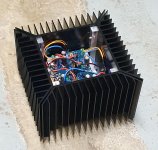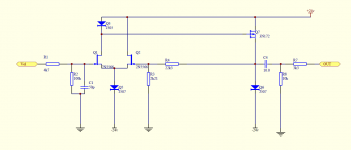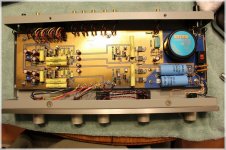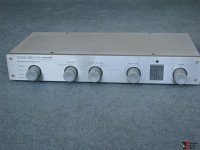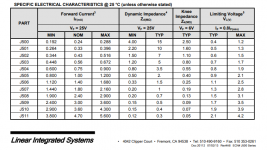... Also I would not drop close to the rated across the current diode if you want reliability you need to add a series resistor......not an issue with a bipolar current source.
The E-101 through E-562 are rated for 100V.
Or are we talking about the J113 & J511?
...I can't find any indication of what Borbely used there...
I don't have the original Borbely boards anymore, but in the repro ones I have it's a 2SK30GR + 330R.
Jeff, you probably know this link ... just in case
EB-604/410 All-JFET Line Amp Starter Kit | audioXpress
Thanks for that, I was not aware of it.
The regulator shown there is slightly different than the one I was looking at, but this one also uses current sources for the Zener and in one leg of the LTP. (He's using an E202 for the Zener and an E102 in the LTP.)
He also has a 3K09/220uF RC filter after his Zener. 😉
I just stumbled over this thread. I might be a bit late to the party, and I have probably missed most of the fun, but...
...looking at these layouts, I am not sure how you're going to spread the output devices across the four "Aleph style" heatsinks. A stereo amp will have 12 output devices (6 per channel). You could spread the outputs by mounting three outputs to each heatsink, but the thermal coupling might be different from what you're used to with "normal" amp chassis. Is that an issue?
Also, your layouts for the boards that take the output devices seem to be rather long -- will they fit the "Aleph style" heatsinks?
I attached a photo of my Aleph J stereo amp (with 1 output per heatsink). Thermal tracking was better during bench testing, when both the "positive" and the "negative" outputs were mounted on the same dummy heatsink. Anyhow, my final build in the "Aleph style" chassis worked out okay in the end.
It's designed to go into a case built around @mbrennwa's Aleph-style heatsinks.
Jam Jar Output Stage
Schematics in PDF; layouts in JPG.
...looking at these layouts, I am not sure how you're going to spread the output devices across the four "Aleph style" heatsinks. A stereo amp will have 12 output devices (6 per channel). You could spread the outputs by mounting three outputs to each heatsink, but the thermal coupling might be different from what you're used to with "normal" amp chassis. Is that an issue?
Also, your layouts for the boards that take the output devices seem to be rather long -- will they fit the "Aleph style" heatsinks?
I attached a photo of my Aleph J stereo amp (with 1 output per heatsink). Thermal tracking was better during bench testing, when both the "positive" and the "negative" outputs were mounted on the same dummy heatsink. Anyhow, my final build in the "Aleph style" chassis worked out okay in the end.
Attachments
He also has a 3K09/220uF RC filter after his Zener. 😉
Yeah.
Common sense stuff.
If this schematic can be trusted, the line stage of the Threshold FET-2 preamp used three of the Siliconix J-nnn current regulating diodes, two JFETs, and a MOSFET.
Linear Integrated Systems now sells identical-spec replacements for the old Siliconix parts
_
Linear Integrated Systems now sells identical-spec replacements for the old Siliconix parts
_
Attachments
Last edited:
I just stumbled over this thread. I might be a bit late to the party, and I have probably missed most of the fun, but...
...looking at these layouts, I am not sure how you're going to spread the output devices across the four "Aleph style" heatsinks. A stereo amp will have 12 output devices (6 per channel). You could spread the outputs by mounting three outputs to each heatsink, but the thermal coupling might be different from what you're used to with "normal" amp chassis. Is that an issue?
Also, your layouts for the boards that take the output devices seem to be rather long -- will they fit the "Aleph style" heatsinks?
I attached a photo of my Aleph J stereo amp (with 1 output per heatsink). Thermal tracking was better during bench testing, when both the "positive" and the "negative" outputs were mounted on the same dummy heatsink. Anyhow, my final build in the "Aleph style" chassis worked out okay in the end.
Hi Matthias,
Yes, the project evolved considerably from its inception. Originally I was looking at two pairs of laterals per channel fed by a current mirror VAS -- so there would have been one pair of outputs per heatsink.
But the current mirror was given the boot due to increased Early effect at the planned rail voltages, and the replacement designs all had more drive and could support more output devices, and one thing led to another....
I still might build a lower-voltage current-mirror version for the Aleph heatsinks, or possibly something completely different.
Cheers,
Jeff.
Jeff. I would say both.
Jam
It occurs to me that if one implements the post-Zener RC filter then
a) the C also functions as a slow start-up capacitor, and
b) the R also keeps the constant current diode from ever seeing the capacitor as a short
At that point the RC filter has zero cost....
Also heat dissipation, I have had a few current diodes fail when operated close to their voltage limits, I usually run the devices at less then half their rated voltage, and have not had a device fail since.
Jam
Jam
Last edited:
I finally got my Kicad bug fixed, so here's a snapshot of where the Hitachi topology (and regulator) are.
One question: if the current mirror degeneration resistors are matched do the transistors still need matching?
OK, another: do I have the matching criteria right (Vbe for current mirrors; hFE for differential pairs)?

One question: if the current mirror degeneration resistors are matched do the transistors still need matching?
OK, another: do I have the matching criteria right (Vbe for current mirrors; hFE for differential pairs)?
Attachments
Here's a regulator I designed & built in 2015. It might possibly contain one or two tidbits of inspiration. (or perhaps one or two crystals of pure disgust.) It's got BJT current sources, it's got a high gain error amplifier, it's got a cascade of lowpass filters in the VREF signal channel, it's got explicit frequency compensation, it's got the ESR of the output capacitor clearly marked, it's got a Walt Jung level shifter, and on and on.
_
_
Attachments
Here's a regulator
_
Using something very similar for my prephono (small differences here and there) ... why don't you supply the OpAmp from the regulated rail?
Gluca, if I'm being honest, it was mostly phobia. Irrational fear of failure-to-start-up.
_
_
Last edited:
Irrational fear of failure-to-start-up.
_
It actually starts with no issues at all
I don't think anybody has built both of them and performed a listening comparison.
To borrow from Carolus Linneaus, they are certainly not the same species, IMO they are probably not in the same genus, but IMO they certainly are in the same family.
Rest in Peace, Cecil McGirr. The man who enthusiastically preached The Linnean System Of Classification Of Organisms. "Fifty years from now you won't remember too much about this class but you will remember TLSOCOO!" He was right.
_
To borrow from Carolus Linneaus, they are certainly not the same species, IMO they are probably not in the same genus, but IMO they certainly are in the same family.
Rest in Peace, Cecil McGirr. The man who enthusiastically preached The Linnean System Of Classification Of Organisms. "Fifty years from now you won't remember too much about this class but you will remember TLSOCOO!" He was right.
_
Last edited:
Jeff,
consider me the first leacher for those 3 pdf... I haven't even looked at them.
I must agree with Jam that this is one of the most interesting threads, I was stunned when I realized it was already at 70something pages...
Looking forward to the build!
Cheers,
Max
consider me the first leacher for those 3 pdf... I haven't even looked at them.
I must agree with Jam that this is one of the most interesting threads, I was stunned when I realized it was already at 70something pages...
Looking forward to the build!
Cheers,
Max
- Home
- Amplifiers
- Pass Labs
- JamJar: an HPA-1-inspired power amp
